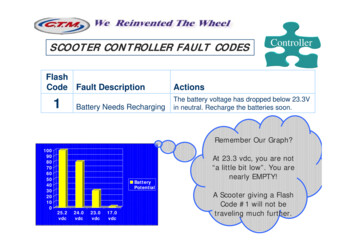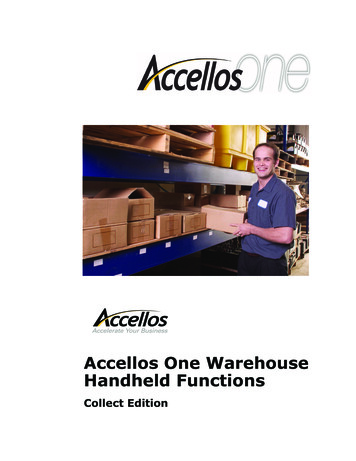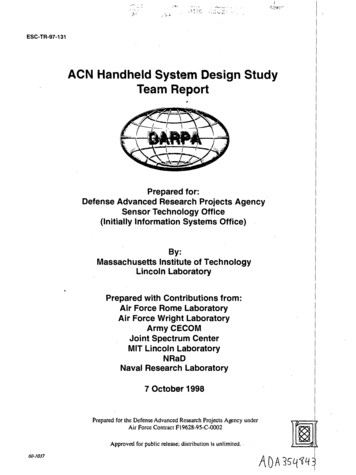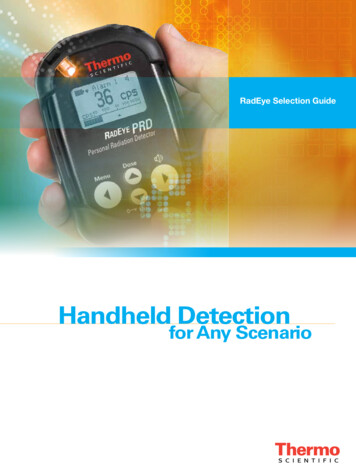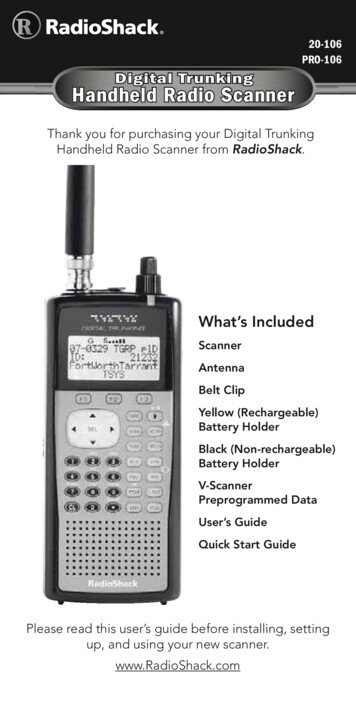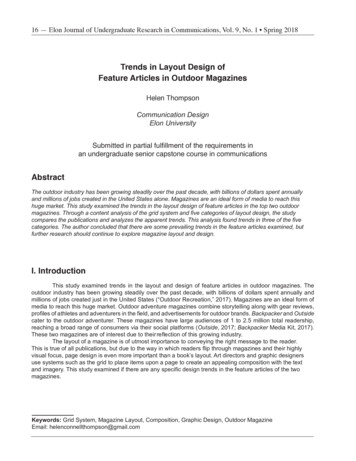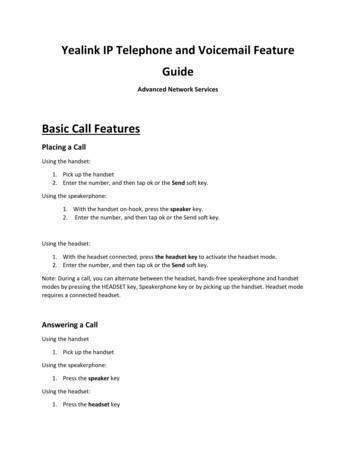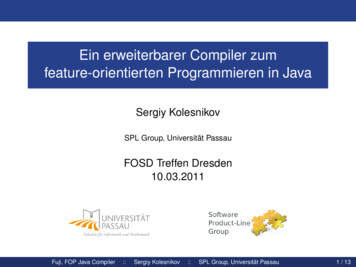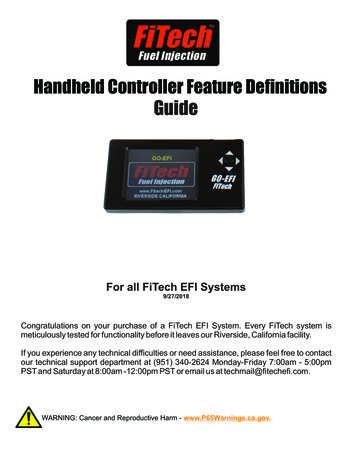
Transcription
Handheld Controller Feature DefinitionsGuideFor all FiTech EFI Systems9/27/2018Congratulations on your purchase of a FiTech EFI System. Every FiTech system ismeticulously tested for functionality before it leaves our Riverside, California facility.If you experience any technical difficulties or need assistance, please feel free to contactour technical support department at (951) 340-2624 Monday-Friday 7:00am - 5:00pmPST and Saturday at 8:00am -12:00pm PST or email us at techmail@fitechefi.com.WARNING: Cancer and Reproductive Harm - www.P65Warnings.ca.gov.
FiTech Fuel Injection System Handheld Controller Feature Definition GuideWARNING!This installation guide must be read and fully understood before beginning installation.If the installation guide is not fully understood, do not attempt to start this installation. Failure to follow this installation guide canpossibly result in system failure and potentially serious personal injury and/or property damage. Please keep this installationguide. For the safety and protection of you, your vehicle, and others, only a trained and FiTech approved mechanic with adequatefuel system experience should perform the installation, adjustment, and repair.Caution must be observed when installing any product involving fuel system parts or gas tank modifications. Work in a wellventilated area with an approved fire extinguisher readily available. Eye protection and other safety apparel should be worn toprotect against debris and sprayed gasoline. Ensure to disconnect the negative terminal of the battery before beginning. Werecommend having this installation performed by an experienced, qualified, and FiTech approved automotive technician. Thefinished installation must be throughly checked for any fuel system leaks. All safety precautions must be observed whenworking with fuel. Lastly, ensure the engine has had sufficient time to cool! Engine fluids may still be hot. Disregarding any ofthis information can result in serious property damage, injury, and/or death.If this installation guide is not followed, any component damaged will not be covered by FiTech’s warranty. Should any onecomponent fail, it will not constitute or justify a warranty of the entire FiTech EFI system. Replacement and accessory items areavailable for purchase from FiTech EFI. If assistance is required or if you need further warranty clarification, please call FiTechEFI (951) 340-2624 or email warranty@fitechefi.com.
Basic Settings: These values and options allowEngine CID Total Engine cubic inchesCam Mild -Wild 1 -4 This is the way to select a specific volumetric efficiency table that is specially tailored to the characteristics oftypical engine configurations.Rev Limit RPM At this RPM, the fuel and spark will be cut off, to limit the engine speed.Idle Spee d Warm The idle speed of the engine when it’s fully warmed up.Fault Clear Set this to 1 to clear the recorded faults out of the system.Reset All Learn Set this to 1 to set all fuel learning values to 100, and all idle air learning to a default value, and TPS closed positionlearning to a default position.Reset Fuel Learn Set this to 1 to set all fuel learning values to 100Reset IAC Learn Set this to 1 to set all idle air learning values to a default value (16 steps)Reset TPS Learn Set this to 1 to set the TPS learn value to a high default position (the TPS closed position will relearn any new valuethat is consistently lower than this).AFR Targets: The AFR table is a 3x3 matrix-the AFR is interpolated between these breakpoint values. This means that if your breakpointsare 45kPa at 14:1 and 95kPa at 12:1, operating at 70kPa will result in 13:1 target.Idle AFR Target Target AFR of fuel control when the engine is at Idle. Most engines will tolerate as rich as 12.7:1, and some will“like” 14:1.1100 45kPa AFR at 1100 RPM and 45kPa-this is typically just “off-idle” with very low throttle opening. Different cams will requiredifferent AFRs at this point. A stock cam will work fine at 14.5:1. A lumpy cam might like 13.3:1 or 14.5:1.3000 45kPa Cruise AFR at 3000 RPM and 45kPa-typical of a light cruise, but not, for example, overdrive cruising at lower RPMs andhigher loads. Suggested range 13.4-14.7:16000 45kPa AFR at 6000 RPM and 45kPa – this is only used in free -rev, or something like autocrossing in a low gear and throttleis just barely open. Suggested range 12.5-13.8:1 (richer to keep parts a little cooler, and so that the tip in in to full throttle is starting from rich.3000 45kPa Cruise AFR at 3000 RPM and 45kPa-typical of a light cruise, but not, for example, overdrive cruising at lower RPMs andhigher loads. Suggested range 13.4 - 14.1:16000 45kPa AFR at 6000 RPM and 45kPa this is only used in free-rev, or something like autocrossing in a low gear and throttle is justbarely open. Suggested range 12.5-13.8:1 (richer to keep parts a little cooler, and so that the tip in to full throttle is starting from rich.Disp AFR filt idle The AFR value displayed in the Dashboard and Data Logging is “filtered” meaning that is shows changes a littleslower than it really senses them, to make the value appear more smooth. If more resolution is desired, increase this number to makechanges appear more quickly. This value only applies to AFR’s displayed while the throttle is CLOSED.Warm Idle Speed This is the Target Idle RPM for when the engine temperature reaches 170 degrees Fahrenheit.Fault Clear 1 Set this to 1 in order to clear any recorded faults. This can be used if a repair has been made, or perhaps if a false faulthas been detected, or fault diagnostics are being done to solve a problem.
WOT 1100 95kPa AFR at approximately 25 -100% throttle at low RPM. Intake manifolds are not very good at cylinder to cylinderdistribution so, there might not be a “perfect” AFR for here, but, 12.6 is a typical good enough AFR.WOT 3000 95kPa AFR at approximately 45-100% throttle at 3000 RPM. Intake manifolds are not very good at cylinder to cylinderdistribution, so, there might not be a “perfect” AFR for here, but, 12.6 is a typical good enough AFR.WOT 6000 95kPa AFR at approximately 75-100% throttle at 6000 RPM. Intake manifolds are not very good at cylinder to cylinderdistribution, so, there might not be a “perfect” AFR for here, but, 12.6 is a typical good enough AFR. But, sustained time at this RPMcan put a lot of heat into the exhaust valves, and richer might be needed to keep temperatures in check (at the expense of somehorsepower).Boost 1100 180kPa This is full throttle but with a supercharger or turbocharger boosting to about 11.6 psi. If no intercooler is used, thethe engine may require as rich as 11.0:1. If an intercooler, other charge cooling device or a fuel with plenty of octane is used, leaner canbe tolerated. Richer than 12.5:1 is recommended.Boost 3000 180kPa This is full throttle but with a supercharger or turbocharger boosting to about 11.6 psi. If not intercooler is used, theengine may require as rich as 11.0:1. If an intercooler, other charge cooling device or a fuel withplenty of octane is used, leaner canbe tolerated. Richer than 12.5:1 is recommended.Boost 6000 180kPa This is full throttle but with a supercharger or turbocharger boosting to about 11.6 psi. If not intercooler is used, theengine may require as rich as 11.0:1. If an intercooler, other charge cooling device or a fuel with plenty of octane is used, leaner can betolerated. Richer than 12.5:1 is recommended.SPARK MAP: The spark advance uses a 3x3 matrix table to allow flexible spark advance control. This can allow distributor simulation,locked timing, boost retards, high RPM advancing and other strategies to optimize the ignition spark advance angle.The distributor mustbe locked out. Spark advance during cranking will happen at or after the VR tooth crosses the sensor. Above cranking spark advance willonly be equal to or more than the base advance, regardless of the value entered in the handheld for timing.Distrib Base deg Adjust this to get the timing light timing to match the displayed Spark Advance at low RPM. It’s recommended to setthis as high as possible, because the amount of advance range from min to max is limited due to the rotor and cap being in a fixedrelationship.VR Advance 4000 Adjust this to get the timing light timing to match the displayed Spark Advance at 4000 RPM. This adjustment forthe small lag inherent in VR signals. It can add up at high RPM.Idle Advance The spark advance desired at idle.1100 45kPa Spark advance used just after throttle opens from idle. This value shouldn’t be much more than the idle Advance, forthis reason.3000 45kPa Cruise Spark Advance used in a light cruise at 3000 RPM and throttle barely open.6000 45kPa Spark Advance used in a high free-rev condition, perhaps also seen when autocrossing and just tipping-in a low gear athigh RPM.WOT 1100 95kPa Spark Advance at low RPM and “full load” – perhaps the throttle is as low as 20% to see this much load. Spark isbased on MA , and MAP (and thus “load”) can get pretty high even with low throttle openings at low low RPMs.WOT 3000 95kPa Spark Advance at high loads and 3000 RPM. This could easily be deemed “total” timing when comparing to adistributor, but due to the flexibility of a 3x3 matrix, this doesn’t limit you as such.WOT 6000 95kPa Spark Advance at high loads and 6000 RPM. At high RPM, some engines require more or less spark advance thanat 3000 RPM. This allows you to set the timing there.
Boost 1100 180kPa This is full throttle but with a supercharger or turbocharger boosting to about 11.6 psi. If no intercooler is used, theengine may require very little spark advance. Remember that timing less than the base advance “Distr Base Deg” is not allowed, sochoose the base timing carefully.Boost 3000 180kPa This is full throttle but with a supercharger or turbocharger boosting to about 11.6 psi. If no intercooler is used, theengine may require very little spark advance. Remember that timing less than the base advance “Distr Base Deg” is not allowed, sochoose the base timing carefully.Boost 6000 180kPa This is full throttle but with a supercharger or turbocharger boosting to about 11.6 psi. If no intercooler is used, theengine may require very little spark advance. Remember that timing less than the base advance“Distr Base Deg” is not allowed, sochoose the base timing carefully.ACCEL PUMP: Intake manifolds are going to get wet with fuel while running. This wetness changes with temperature, engine vacuum,and air flow speeds. This wetness also must be supplied in addition to the fuel that is intended to reach the cylinders. This wet film offuel on the surface is much thicker at cold engine (fuel doesn’t evaporate well when cold), and also varies greatly with vacuum (biggerat high loads, smaller at low loads). The software has a strategy to supply that fuel and compensate for the changing size of the film.However, different manifolds have different characteristics, so some adjustments may be necessary to give the proper fuel during a“transient” event (transient is a term used to describe moving the throttle and changing the load). The fuel added during a transient hasto be added in a special way to a special way to cause the wetness to build correctly over several injections. It starts out large, and decaysto 0. The decay adjustment shape that curve. A larger decay value causes the accel “pump” amount to be ended sooner, and a smallerdecay value allows the fuel to extend a little longer. It’s a fine art of calibration to get this perfect, requiring a super- fast reading of alambda sensor. It’s recommended to only adjust these values when you notice it’s a problem. it also shouldn’t ne adjusted must until thefuel learning has had plenty of time to adapt to the engine. The Accel Fuel calculation uses 2 different signals that work independentlydetermine how much fuel to add/subtract. The MAP is directly used for “Accel Pump” fuel. The Alpha - N MAP is used for the “Fast Accel”fuel. Alpha-N uses the TPS and RPM to calculate a secondary “MAP” signal in case of the pump fault. That value is also used to calculatethe “Fast Accel” fuel, because it responds slightly faster than the real MAP signal.Accel Pump 20F Adjusts the fuel film compensation when very cold. 0 means it uses the default calibration directly.Fast Decay 65F Same, but for 65F.Fast Decay 170F Same, but fo r warm engine.Accel Decay 65F Same, but for 65F.Accel Decay 170F Same, but for warm engine.Accel Pump 65F Adjusts the fuel film compensation when cold. 0 means it uses the default calibration directly.Accel Pump 170F Adjusts the fuel film compensation when warm. 0 means it uses the default calibration directly . The default calibrationalready has a background table that is set up to work pretty good “out of the box” but it maybe too lean or too rich during quick tip-ins forcertain enginer.Accel Decay 20F A larger decay will shorten the amount of time that the injectors are adding fuel during a transient. A smaller decaywill extend the time. 0 will use the default values that are in the default calibration.dTPS Acc Gain In order to “help” the acceleration fuel be large enough to handle a sudden throttle snap open, the speed of throttleopening is used as a bit of a helper to make it bigger as the speed of the throttle is opened faster. A larger number here will make it moresensitive to throttle opening speed.dTPS Acc Max The dTPS fuel gain multiplier is limited to this amount. 100 means that no help is given by this function. 199 means thatthe Fast Accel fuel is nearly doubled if the throttle is moved quickly enough.
Tipout -20F “Tipout” is the term used to describe when the throttle is closing. The MAP drops rapidly, which means vacuum increasesrapidly, and the fuel suddenly vaporizes off of the wall, and the injected fuel quantity is less. The wall film of fuel will decrease greatly, andthus if the injection rate is kept the same, the engine will be very rich. The software compensates this using a default calibration for thewall film, but the adjustments provided here can allow mpre precise adjustment for the varying engine configuration.Tipout 0F sameTipout 40F sameTipout 70F sameTipout 120F sameTipout 150F sameTipout 185F sameTipout 215F sameFUEL CONTROL: A speed density algorithm is used to calculate the fuel injection pulsewidth. The temperature used is called the “InCylinder Temperature” which is calculated as being somewhere between the coolant temperature and the air temperature, dependingon the air flowrate. However, this may not be perfect for the engine configuration when combined with the “warm up” and “start up” fuelmultipliers, and thus the below adjustments are provided to fine tune the system at various temperatures. The speed density calculationdoes not apply when the engine is Cranking (speed below about 450 RPM). After combustion starts and the speed picks up above about500 RPM, the engine begins the speed density calculation, along with the “Warm Up” and “Afterstart” fuel.Warm Up fuel is using a default table (more enrichment at colder engine) that can be tweaked here if needed– warm up fuel works at alloperating conditions above cranking, but is 0 at a fully warm engine.Afterstart fuel enrichment has the special purpose of bui lding the wall fuel films in manifold and cylinder is decreased with the numberof revolutions as the film builds and the parts warm up rapidly - most of Afterstart fuel is one within about 800 revolutions. The adjustmentsprovided here can help fine tune it to the particular application.Fuel -20F Cyl This affects all of the fuel at this In-Cylinder temperature, except the cranking fuel.Fuel 5F Cyl This affects all of the fuel at this In-Cylinder temperature, except the cranking fuel.Fuel 32F Cyl This affects all of the fuel at this In-Cylinder temperature, except the cranking fuel.Fuel 70F Cyl This affects all of the fuel at this In-Cylinder temperature, except the cranking fuel.Fuel 85F Cyl This affects all of the fuel at this In-Cylinder temperature, except the cranking fuel.Fuel 105F Cyl This affects all of the fuel at this In-Cylinder temperature, except the cranking fuel.Fuel 130F Cyl This affects all of the fuel at this In-Cylinder temperature, except the cranking fuel.Fuel 195F Cyl This affects all of the fuel at this In-Cylinder temperature, except the cranking fuel.Afterstart 20F This affects the fuel at this Coolant Temperature, just after cranking, and lasts for just a few seconds.Afterstart 65F This affects the fuel at this Coolant Temperature, just after cranking, and lasts for just a few seconds.Afterstart 170F This affects the fuel at this Coolant Temperature, just after cranking, and lasts for just a few seconds.Warmup 20F This affects all of the fuel at this Coolant Temperature, except the cranking fuel.
Warmup 65F This affects all of the fuel at this Coolant Temperature, except the cranking fuel.Rev Limit RPM Above this engine speed, the fuel and spark will be turned off.Dfco Enable Temp Above this temperature, Deceleration Fuel Cutoff can be used.Dfco Cut Fuel MAP Below this MAP, Deceleration Fuel Cutoff can be used.Dfco Return MAP Above this MAP, Deceleration Fuel Cutoff will be exited, and fuel injection returned.Dfco Return Fuel When the fuel injection returns, extra fuel is required to wet the intake manifold walls, to avoid going lean.Dry Ring Fill PW The fuel distribution rings need to be re-filled – since they don’t change size, this value should be correct in the defaultcalibration.Fast Accel 20F Adjusts the fuel film compensation when very cold. 0 means it uses the default calibration directly.Fast Accel 65F Adjusts the fuel film compensation when cold. 0 means it uses the default calibration directly.Fast Accel 170F Adjusts the fuel film compensation when warm. 0 means it uses the default calibration directly.Fast Decay 20F A larger decay will shorten the amount of time that the injectors are adding fuel during a transient. A smaller decay willextend the time. 0 will use the default values that are in the default calibration.Max drpm Drop rate If the RPM is dropping very quickly, such as when shifting gears or other clutched event in a manual transmission,Deceleration Fuel Cutoff will be exited early, and fuel injection will return.Fault Rev Limit In the case of some sensor faults, the rev limit can be reduced to act as a protection and as a warning in case the driverwasn’t aware of a fault.REV LIMIT DECEL CUT: During certain situations, the injectors can be turned off. At high RPM, the injectors and spark can be cut offat the Rev Limit RPM in order to prevent the engine from over speeding and causing engine damage. This can be a fairly sudden jerkingfeeling, and shouldn’t be used to hold an RPM point. DFCO stands for Decelleration Fuel Cut Off. When decelerating in gear, the MAPis very low, which means the fuel pulsewidths are very small. The engine also has a very high amount of internal EGR, which causescombustion to be very difficult. Also, torque is not even desired, so, fuel can be cut off. This will appear as a very lean condition, but don’tworry -it’s far from any kind of danger - there’s no fuel at all! When the throttle is opened, or the RPMs approach idle, or some other thingcauses more load on the engine,the fuel injection returns. Because the manifold will be dried out during the time of no injection, extra fuel“Dfco Return Fuel”is needed to re-wet it, to avoid a long lean out period. Because there are distribution rings in the path of the injectionspray, the voids in that ring need to be re-filled as well before fuel will flow steadily out of the discharge holes Dry Ring Fill PW is used inthis situation.CRANKING FUEL: The fuel requirements during cranking are very far from the speed density calculated amount. Thus, the fuel is notusing that equation during the time betw
FiTech Fuel Injection System Handheld Controller Feature Definition Guide WARNING! . Disp AFR filt idle The AFR value displayed in the Dashboard and Data Logging is “filtered” meaning that is shows changes a little slower than it really senses them, to make the value appear more
